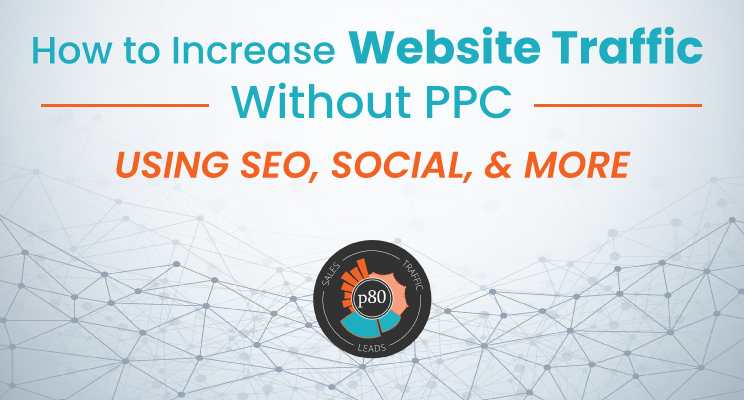Inbound Marketing Blog
for Manufacturers and Healthcare Companies
How to Increase Website Traffic Without PPC Using SEO, Social & More

Pay-per-click (PPC) advertising is a great, and often very impactful, way to quickly generate website traffic.
However, the PPC model may not be a good fit for every situation.
No need to panic! You can absolutely still increase traffic to your website through Google and other search engines, even without ads. Even if PPC could or has already worked for your company, did you know that increasing organic (nonpaid) traffic often has a more cost-efficient and long-term impact than paying for traffic? Eventually weaning off PPC is actually a common theme of B2B marketing budget allocation once your traffic numbers are off and running.
PPC is like a snow-making machine you'd find on a Hollywood set or a ski slope. Once you turn it off, the results stop. High organic search rankings, however, are like a winter wonderland of traffic and leads that keep working months or even years after you publish a page.
In this post, we’ll share six super-effective alternatives to PPC advertising that'll help your traffic and search rankings:
6 Pay-Per-Click Alternative Strategies
Looking for pay-per-click (PPC) advertising alternatives that create an avalanche of momentum that pays for itself over time? Here's how to increase website visitors for free or cheap -- the organic way:
- Keywords
- Technical SEO
- Linking
- Email marketing
- Social media
- More content!
1. Use Keywords That Match Your Persona's Searches
Search engine optimization (SEO) is the practice of improving a site's ranking in Google and other search engines. One of the foundational ways to make your website more visible in Google is through keywords.
SEO keyword best practices boil down to three questions:
- Does each page on your website feature a primary keyword, used in the right places?
- Does each page feature supporting keywords that further clarify your page's intent?
- Do your keywords match the "search intent" of your ideal buyer?
"Search intent" means your keywords should be focused and relevant to the type of person you want to attract to a given page. Research keywords with your customers in mind -- how would they describe a problem or product to a search engine? That's what you should be writing web content about, and that's where your keyword clues live.
Identify a list of keywords through:
- Buyer interviews
- Competitor research
- Auditing your own website
- Asking your sales team about any FAQs they hear
(p80 Resource: How to Pick Keywords for Your Website)
2. Fix Technical SEO/UX Issues
As of mid-2021, Google accounted for over 90% of all search traffic. If you want your site to be seen, you must make it easy for both search engines and humans to understand and navigate.
While some tactics are easier than others, as a whole, SEO is fairly difficult to do without the help of a specialist. A truly strong B2B SEO strategy requires research, testing, data analysis, and a strong understanding of what works and what doesn’t.
You, your developer, or your website/SEO agency can start by checking for these common technical SEO issues:
- HTTP/HTTPS content & code errors
- Broken images, files, & links
- Slow page loading
- Missing, duplicate, or poorly written meta & title tags
The Indirect Effect
Even user-experience (UX) issues that aren't technically "errors" can still ruin your SEO.
For example, say your website has confusing menu navigation, and 95% of its pages are "dead ends" with no lead-capture opportunity or next steps presented to the visitor. Chances are they'll leave, right?
Bounce rate (% of visitors who leave after only visiting a single page of your site) and average time on page (self-explanatory) are two huge Google SEO ranking factors. Therefore, if your site keeps giving your visitors reasons to skedaddle, your rankings will suffer.
(p80 Resource: How to Squash Common Technical SEO Issues)
3. Link Building, Inside & Out
Of all the concepts we’ll cover today, B2B backlinking referrals are, without a doubt, the most difficult to achieve. You have less control over your ability to grow these "external" links, and you won’t be able to obtain a large volume of them immediately.
But, man, search engines sure love sites that earn lots of backlinks. Why? Because it shows other people and companies trust and value your page's content.
You obtain "referral" traffic by getting a link to your website included on another company’s website. These could come from a variety of places -- anything from an industry publication sharing a piece of your content, to a satisfied customer posting about your services on their own website.
Don't forget about organizations you’re a member of! If you’re a member of the local chamber or regional/national industry groups, this is an awesome way to get shoutouts that will spread your company’s good name.
You’re not going to get very far if you constantly pester people for links. Instead, create helpful and unique content (like a how-to blog post) that will naturally grow links because people want to share it. Certain types of content tend to be especially good at generating backlinks:
- Stat- and data-backed posts
- Infographics
- Industry trend pieces
Any time you’re being linked to from another site, make sure that the link back to your website is working properly.
Guest Posting
Once you're established in your industry -- and even more so once you've earned some thought-leadership clout online -- you can seek guest-posting gigs.
Consider writing a guest article for a site where your ideal buyers hang out -- or, vice versa, asking one of those sites' respected expects to write for your own site. When you seek a content partnership, don't make your proposal one-sided -- explain they'll get a valuable backlink and/or content for their site, too.
4. Email Marketing
While some might think of B2B email marketing strategies as a graveyard of spam, email is actually alive and well. After all, what good are your amazing website content if nobody knows it exists?
As you collect email contacts through website forms, trade shows, etc., educate and nurture these leads by sharing links to your site's content.
The goal of email marketing is providing helpful (not sales-y) content to potential and current customers. Remember, the B2B sales cycle is often months or years long -- prospects often need education during that long in-between period. Your content can fill that gap and keep your brand top-of-mind when they finally are ready to buy.
5. Social Media Sharing
People use social media a lot -- and not always to see pictures of their grandnephews building a snowman!
Consistent and education-first B2B social media strategies allow you to get in front of new potential customers. Again, the key is to share links to genuinely helpful content, drawing traffic to your website.
The keys to successful social content are relevancy, consistency, and communication. Tweeting once every other week isn't going to do anything for you. However, if you provide consistent, topical content to your followers on a regular basis, you'll start to build up a loyal following that provides you the site traffic you’re seeking.
Just make sure that you’re posting on the social networks that your prospects are actually using. If your target audience is aging Rust Belt manufacturers, chances are TikTok twerking videos aren't going to be the best investment.
The most important takeaway for implementing a successful social media strategy is to consistently share relevant original (as well as third-party) content. Add relevant B2B hashtags to attract readers who aren't currently following your profile page.
Don't Forget Forums & Group Discussions!
Depending on your industry, there are many other platforms that can help you market your niche or small business on a budget.
The key to success when looking for forums to contribute on is to find a “hub” for your industry, where different companies with similar goals can share their content to help each other learn and grow. It may sound crazy, but sometimes your competitors can actually help your business!
If you can find relevant groups that are having discussions around the topics related to your business and provide valuable insight, eventually you'll get noticed. By growing your personal brand as a thought leader, you'll also distinguish yourself in a sea of similar content.
 For example, Luminite is a super-niche maker of products for the flexographic printing industry. By sharing several educational blog posts over the years at industry publication FlexoGlobal, Luminite earned tons of new traffic and leads.
For example, Luminite is a super-niche maker of products for the flexographic printing industry. By sharing several educational blog posts over the years at industry publication FlexoGlobal, Luminite earned tons of new traffic and leads.
Another great place to join the conversation is LinkedIn. There, you not only have the opportunity to share thought-provoking, conversation-starting content, but also a chance to network and develop business connections within your industry. In other words:
- You get to share your content with a business-mindset audience
- You watch traffic to your website increase
- You're networking the whole time -- just by posting on a forum!
6. Create More Content!
For your business to increase its website ranking in Google Search, you have to post relevant, useful content -- the more, the better. This content can speak to potential customers or even current clientele from whom you’d love to see repeat business.
Organic SEO takes time to develop, but results will come more quickly if you invest more time in B2B content marketing.
Relevance is key, so choose topics related to issues and opportunities your business or product can address. For example, a precision machining shop could educate its prospects about the best grades of steel to use in corrosive environments. However, those prospects, probably don't want to read about your company Christmas party, no matter how cute you think it was.
Content is also not a self-promotional tool. Don't sell -- help! Each content piece should be driven by specific keywords that allow Google to easily identify the topic and drive great-fit leads to your site.
SEO First (but Other Stuff Too)
These are awesome tactics to implement if you want to increase website traffic, but you shiver when thinking of how much you spend on your marketing budget.
SEO, social networking, and email marketing can all provide value to your site in their own ways. SEO is a must for any company; how much you focus on the other two will depend on how and where your ideal buyer prefers to learn.
A final note on reducing or ending your PPC efforts in favor of SEO: You won't see results overnight. SEO requires a long-run strategy that will snowball (in a good way) over time. Don't expect to rank atop Google search engine results in month #1.
Easily the most impressive aspect of SEO over PPC is the long-term return on your investment. Your efforts will compound over time as long as your content and keywords remain relevant.
To get an expanded checklist of where to focus your B2B website SEO efforts, grab this free resource:
(This blog post was originally published in February 2020 and was recently updated.)
Our Blogs, Direct to Your Inbox!
How to Audit your Online Marketing
If you are executing digital marketing, congratulations! You are most likely already one step ahead of your competition, and making strides to meaningfully connect with prospects online. But, how do you know if you’re seeing continual success year over year, and improving your metrics?
Without the tools in place to analyze and benchmark your efforts, it is impossible to scale your online marketing and ensure continuous success.



